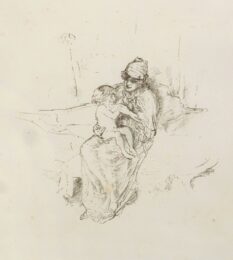

1894 - 1903
Perhaps best known for a painting of his mother titled Whistler’s Mother, James Abbott McNeill Whistler was born in Massachusetts but spent much of his time in Europe. Whistler is known as the father of Tonalism which is an artistic style marked by dark hues such as brown or blue and also emphasized mood and shadow.
Due to his father’s employment on a railroad, Whistler spent significant amounts of time in Russia and England. It was in Russia where Whistler began to hone the craft which would make him famous someday. In 1844, a young Whistler met Sir William Allan, a noted artist of the time and according to Whistler’s mother’s diary, Allen described Whistler as having an “uncommon genius.”
Despite his mother’s wishes that Whistler become a minister, he joined West Point which was perhaps somewhat expected of him as his father and several other relatives also attended West Point. After openly going against authority on many occasions, Whistler was dismissed by none other than Robert E Lee. However, the experience was not wasted as he learned to draw and make maps during his time at West Point. He would use this after the experience to work as a draftsman.
At the age of 21, Whistler left for Paris and he would never again return to the United States. He studied art in Paris and in 1958 created his first self-portrait as well as other works. It was at this time that Whistler also began to socialize with other artists. Whistler returned to London and continued to paint and it was here that he had his first work exhibited. Others works soon followed the first and within a couple of years Whistler began to establish his technique which would become known as Tonalism.
Whistler’s first famous painting, Symphony in White, No. 1: The White Girl, was the first of several paintings of his mistress, Joanna Hiffernan. There were many portraits to follow but none as common as the work Whistler’s Mother, which occurred out of coincidence when a model failed to appear one day and his mother filled in. The painting was purchased by the French government and became the first of Whistler’s works to be in a public collection.
Whistler was also known for arguing on behalf of “art for art’s sake.” Which is the notion that art should exist for aesthetic pleasure rather than to project social or political ideology onto the canvas. Whistler is said to have a significant influence on many famous people of his era including Oscar Wilde and Arthur Frank Mathews. Though the relationship with Oscar Wilde eventually went south. Despite being a short and slight man, Whistler dressed well and was witty and entertaining. It seems he enjoyed being the focus of attention. Whistler rarely shied away from controversy surrounding his opinions about art. While not all critics were kind to Whistler, many noted his influence on art and certain movements within several mediums. Like many artists, Whistler painted until his death in 1903 in London.